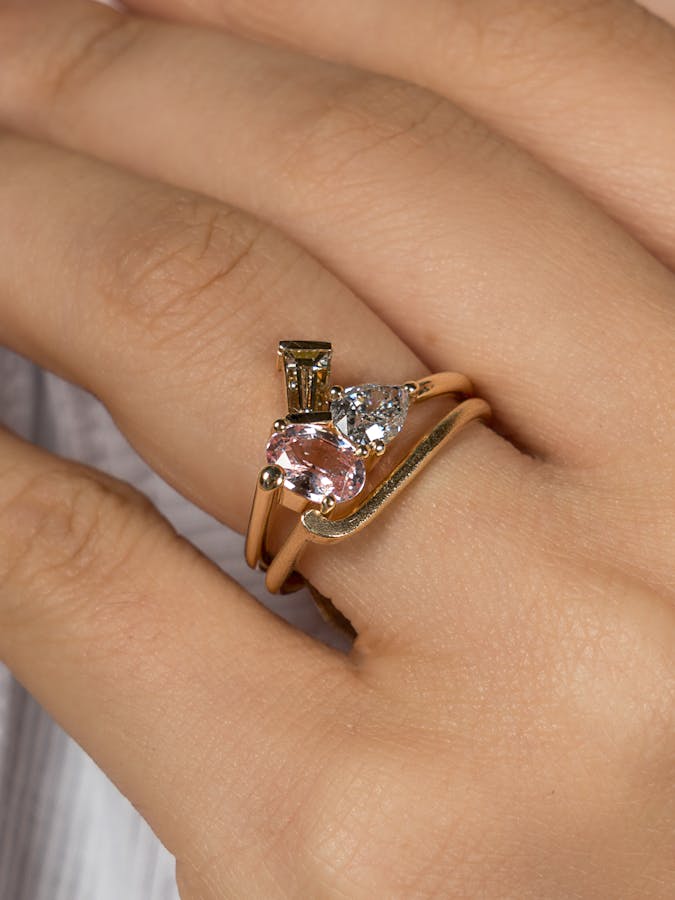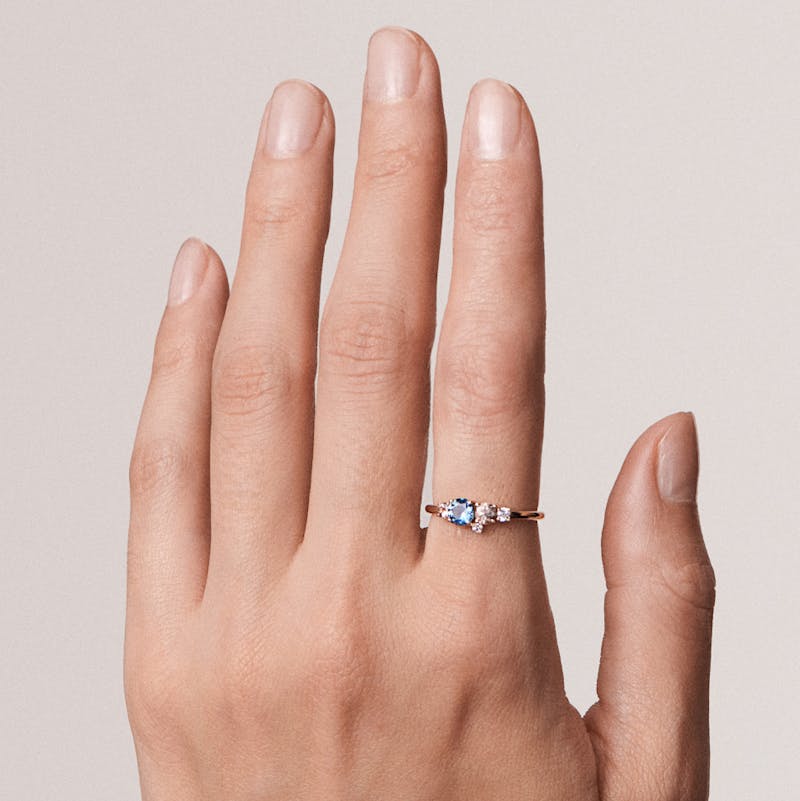Jo Riis-Hansen
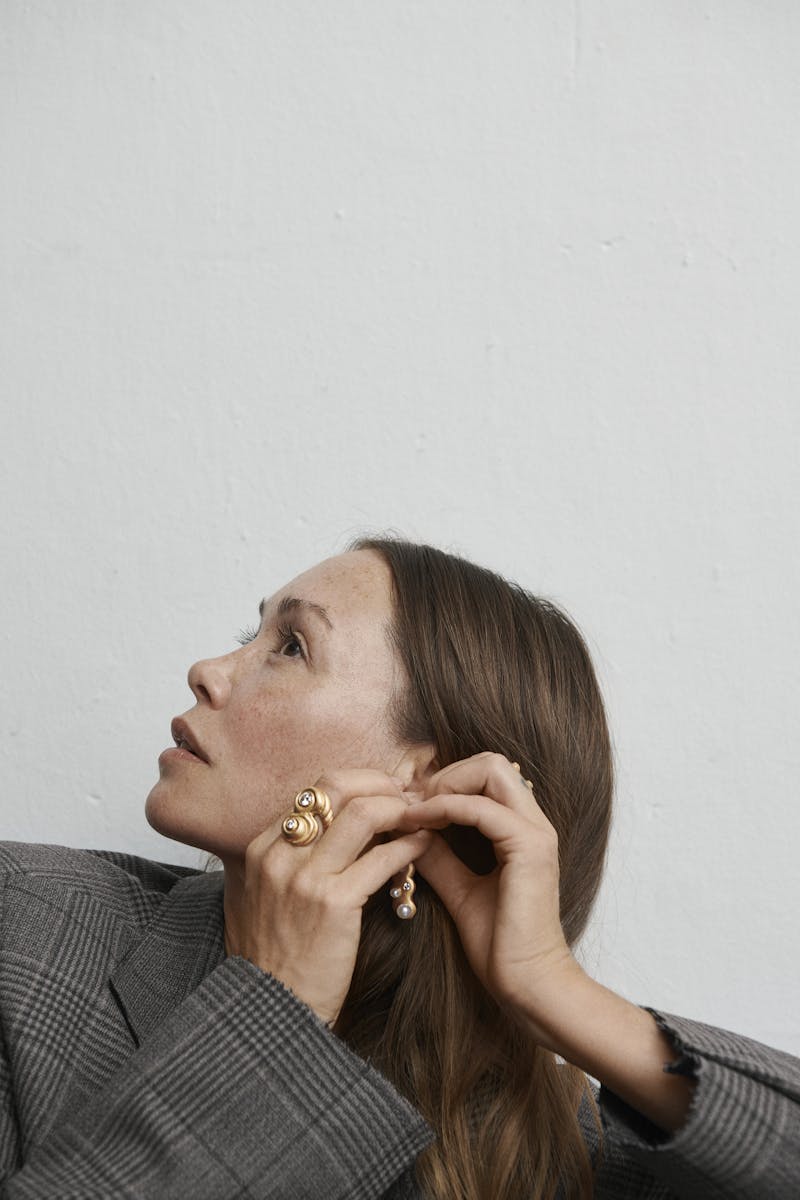
With remarkable talent and visionary ideas, Jo Riis-Hansen is one of her generation's most extraordinary designers
It takes a certain character to reinvent oneself; it takes even more to push the boundaries for what jewellery can be. With originality and creativity, Jo Riis-Hansen has explored the possibilities of her craft from the very beginning, insisting on changing people’s perceptions and preferences. From fashion accessories to wearable art
pieces, Jo is never afraid to follow her intuition, creating disruptions wherever she goes. With an exclusive collection created for Finematter, she’s once again ventured into new territory. Here, she recounts the experiences that have shaped her journey to becoming one of jewellery-making’s most innovative figures.
Tracing your story from the very beginning up until today, there’s this connection between art and fashion that runs through your work and your development as a jewellery designer?
I like to find the voids. I like to go against the stream. When I opened up my first store, the jewellery industry worked in a certain way. In Denmark at least, jewellery was very traditional; Solitaire rings and strings of pearls. Often, I would find myself in high street stores, where they sold these novelties, and I would wonder why it wasn’t made in precious metals and stones. I was very interested in fashion and its cyclical approach.
When was this?
This was in 2000 or 2001, and I feel completely different about it today. But at the time, it was very exciting. When I read about this storefront in a newspaper, I decided to take it. I had just finished my apprenticeship, having done someone else’s creations for four years, because that’s what you do. When I started on my own, I decided to just do the pieces I had been wanting so much, but in precious metals and stones. I wanted it to be modern and fashionable with a fast approach, but in pieces that had meaning. I loved the jewellery of childhood like friendship bracelets and rings you would pull in vending machines. There were so many memories and so much love attached to them, and it felt devastating when they broke. So, I did pieces like that, but in precious materials and diamonds to make them last, and to hold people’s memories. Jewellery is all about memories.
And that was the first…?
That was the first, yes. And in those years, when I had my store, I got more and more hooked on fashion. Why not make jewellery an accessory? Not to devalue jewellery, but to make it just as important as any other accessory. It sounds weird saying that now, because it is exactly what jewellery has become. It’s very interesting to look back at now though, because it was such a good idea for the time. Looking back at it now, I almost feel like saying, be careful what you wish for. It was such a good idea that I felt almost suffocated by it towards the end.
I read in another interview your description of what art jewellery was back then…
Yes, that was the alternative option back then. It would be unwearable art pieces like a marshmallow on a stick only meant to be exhibited. A pair of fake teeth to put on your forehead. It did not attract me at all, because no one would ever wear it. I was not attracted to the very weird. Today, I find stuff like that artistically interesting and it can be thought-provoking too. It still lacks wearability, but I can appreciate the ideas.
And that brings us to where we are today; your new pieces are actually artworks that can be worn?
I’ve been debating with myself when you can call something art, because my pieces are indeed wearable. But in the end, it doesn’t really matter, because they happen in this certain process of creation, and that process is very artistic. The way that I create today is very different. Back then I created stuff that I liked myself, but always for someone else. It was very much about what people wanted and what was fashionable at the time. It was fast and I created it in seasonal cycles. And it was so much fun to figure out that commercialization. How could I make jewellery something people would buy in the same way that they would buy a pair of sunglasses? It’s been a long and weird journey, where I’ve made a complete U-turn. I definitely create from a completely opposite point of view now.
"The energy that you put into creating a piece of jewellery, someone purchases that, and the person can feel that energy."
As you mentioned in the beginning; it’s all about exploring the voids?
I’ve always enjoyed that. And, even if I’ve never actually said it out loud, with the major focus on sustainability, we experience now, I’ve always believed that things need to have a justification to exist.
It’s a new set-up too, working with a gallery?
It’s completely different, and it’s been very exciting. I am someone who has a hard time staying in the same thing for too long. I like a challenge, and I like a deadline. I like working with dogmas. I like setting a goal, deciding on a topic, and then exploring and responding to it. And that’s how it’s always been.
These dogmas. Which ones are you working with right now?
I like to explore boundaries. Particularly my own. I will challenge myself by creating something from a metal I do not particularly love; like silver. I was always obsessed with gold, so I decided to force myself to create a project in silver. It was a frustrating process, having to create something beautiful from a material that did not immediately turn me on. But I ended up loving the result. It’s about shedding the old layers. The discovery of your own creativity is extremely exciting and provocative, and strenuous, unbearable, nerve-wracking, and a whole lot of other things. But when I land on both feet somewhere new, it is all worth it.
Right now, it seems like it’s all about finding a balance, exploring the framework and pushing it, and even if it’s wild, it still has to be wearable?
To me, that’s what characterizes a piece of jewellery; wearability and beauty. You might not wear it on a regular Tuesday, but I want people to use it. And most often, jewellery is connected to memories. You build a relationship with your jewellery. It deserves respect, and to me, there’s not that much respect in hiding them in a box somewhere to never be looked at. To me that’s not its value.
I read the description talisman somewhere, in relation to your jewellery.
It’s in relation to the things I’ve created after my commercial projects. I decided to not care what people thought about it, and I gave myself some years, where it was not about earnings and turnover and all that, and it became a new dogma for me to make people purchase jewellery differently. I put everything else aside, and focused on what I believe in, what I like, with the process as the only purpose. The goal is to challenge myself and push myself. It had to be different. I used to always do small and very minimalistic jewellery, whereas now, I make big organic shapes.
And your inspiration, it comes from inside yourself?
It comes very much from within and in the process. I did these small spunks, small clouds, they don’t have a name. I started working in wax, which was something I would never do before, because where I come from it is not perceived as real craftsmanship, but this time around, I just didn’t care. And then it became such a cool process. I’ve probably done 500 different weird shapes, and none of them were just right. I’m sure no one else could tell. Suddenly, after three months, it was just right. I cannot explain why, it is just a feeling that I have. There’s that one right shape, and that’s the way it is supposed to be. It’s about proportions and process.
It must be very liberating, given that it all comes from within, to have completely let go of working with the customers’ needs in mind?
Yes, but it was also difficult. I’m not different from everyone else; I want people to like me, and to like the things I make. I want praise and recognition, just like everyone else. But I had reached a point, and an age, where I felt like I had to let go of these things and create a personal project. I had to really work with myself and teach myself to not care.
Subjectively, looking at it from the outside, the result is exceptional. Many people feel the same way about your new pieces, which must be amazing now that you’ve let go of other people’s expectations?
It is truly amazing. You can never fully let go of feelings like that. But it’s a process, and it’s still a goal. After 20 years in the industry, and through life in general, to use your creativity to evolve personally, is amazing. I’ve been lucky to be able to do just that for the last three years; it’s been such a liberty. And the funny thing is, now I’ve solved it. It’s been very satisfactory.
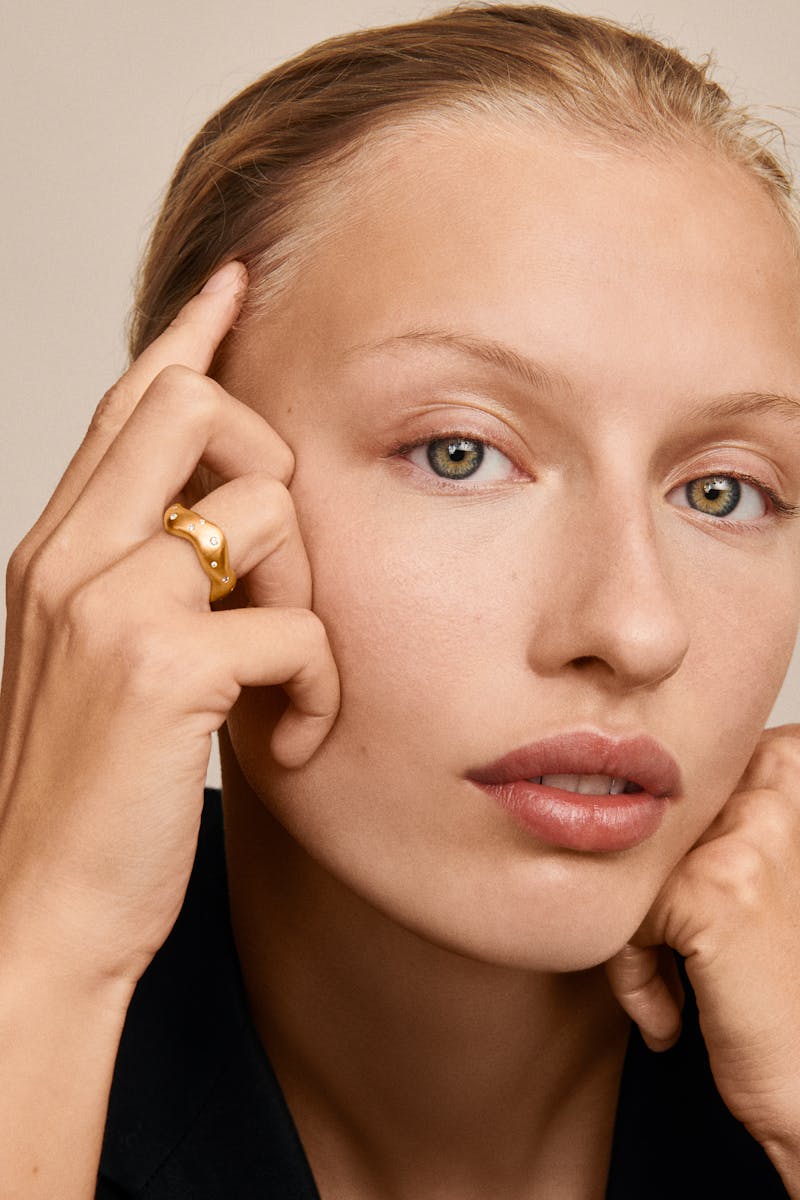
As you mention, it is a privilege to take three years to just sit down and focus, and this slowing down…
It’s been tremendously important. I was so stressed out before.
Is that what we all need to do? To slow down.
Absolutely. When you create jewellery, and with the idea of the talisman, and now it becomes a bit weird, but it’s quite simple; the energy that you put into creating a piece of jewellery, someone purchases that, and the person can feel that energy. I am pretty sure you can feel the difference in how it’s made. What was the intention? That’s my new mantra, to give importance to everything I do. Jewellery is something you wear close to your body and it bears so many memories, so it should be made with love and in bliss to pass on exactly those qualities.
And with the energy from the creator, the piece might also be more open and receptive to the energy from the wearer?
Precisely. And that is the purpose of the project with the gallery; everything is unique. The pieces are so precious, but then you won’t need any other jewellery. This buy and throw away culture, and the commercialization, I had enough of it. I want people to buy something that they will keep forever. It has to be incredibly special. The shapes and inspiration were about intuition and emotion.
Another thing that I find very interesting is your work with ceramics; especially in relation to discovering voids and challenging your creativity and maybe also reset?
It was definitely a way of resetting. It was about a craft, because when you’ve been to school and have been an apprentice, you also learn some bad habits. There’s a certain way of doing things. The idea is that to build a house, you have to set the stones in a specific way, otherwise the house will collapse. But that is not necessarily true. Had we not tried to set the stones a little differently along the way, we would not be living in high rises today. Metaphorically, it feels like I have built some tilted houses now, and I’ve developed a new way of finding solid ground for myself; by picking up the pieces and starting over. Setting them a little differently. With the ceramics, I let myself be really bad at something. It was so frustrating. But it was a way to explore and find a new path in being bad at something in order to eventually land somewhere new. It was a rewarding approach, creatively.
And now you’re back at what it was all about from the beginning; the jewellery. Can you tell me a little bit about the collection you’ve made for Finematter?
I love opposites, I love diversity; so, I wanted to merge simple shapes with the extravagant. The organic curves of the ocean in contrast to the sharp horizon. The black night sky with the bright and shiny stars. I have used a lot of tiny diamonds in the pieces to resemble that light and beauty, most likely to be found in the smallest of places, and smallest of things that human beings create. The pieces are a celebration of unity and love. But also, a reflection on the fact that you cannot enjoy the light if you don’t know the dark. They are a translation of the beautiful quote from the song Anthem by Leonard Cohen, “There is a crack, a crack in everything. That’s how the light gets in”.
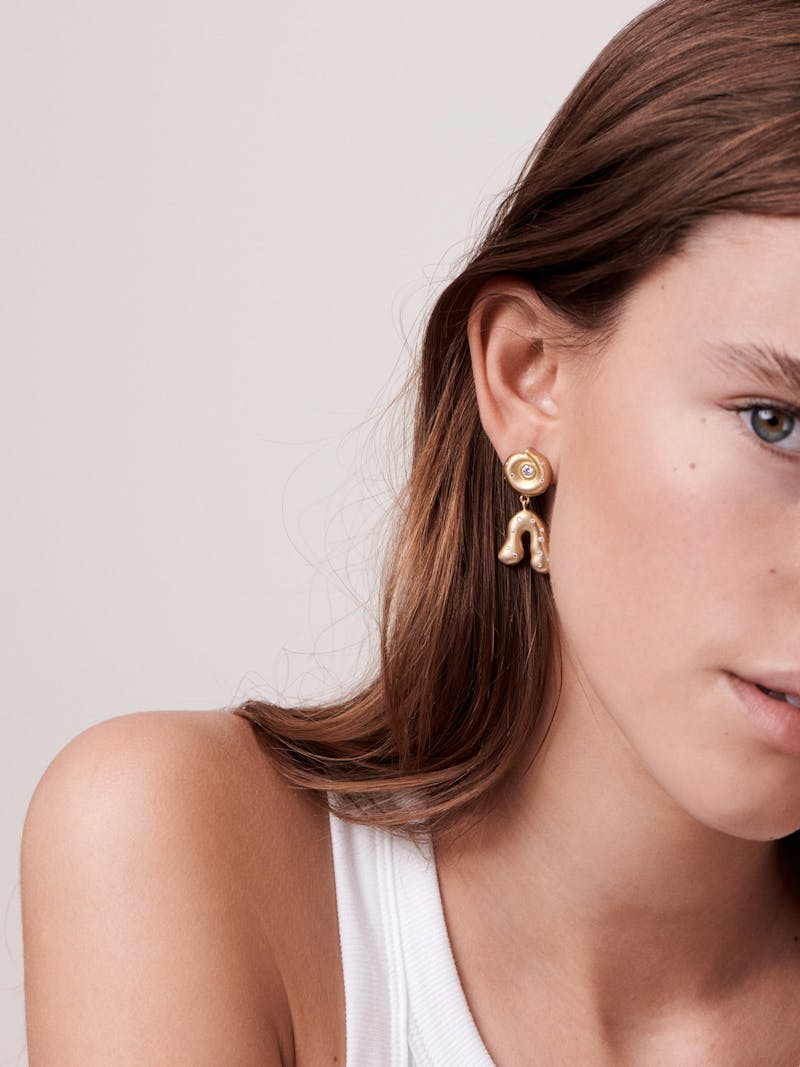
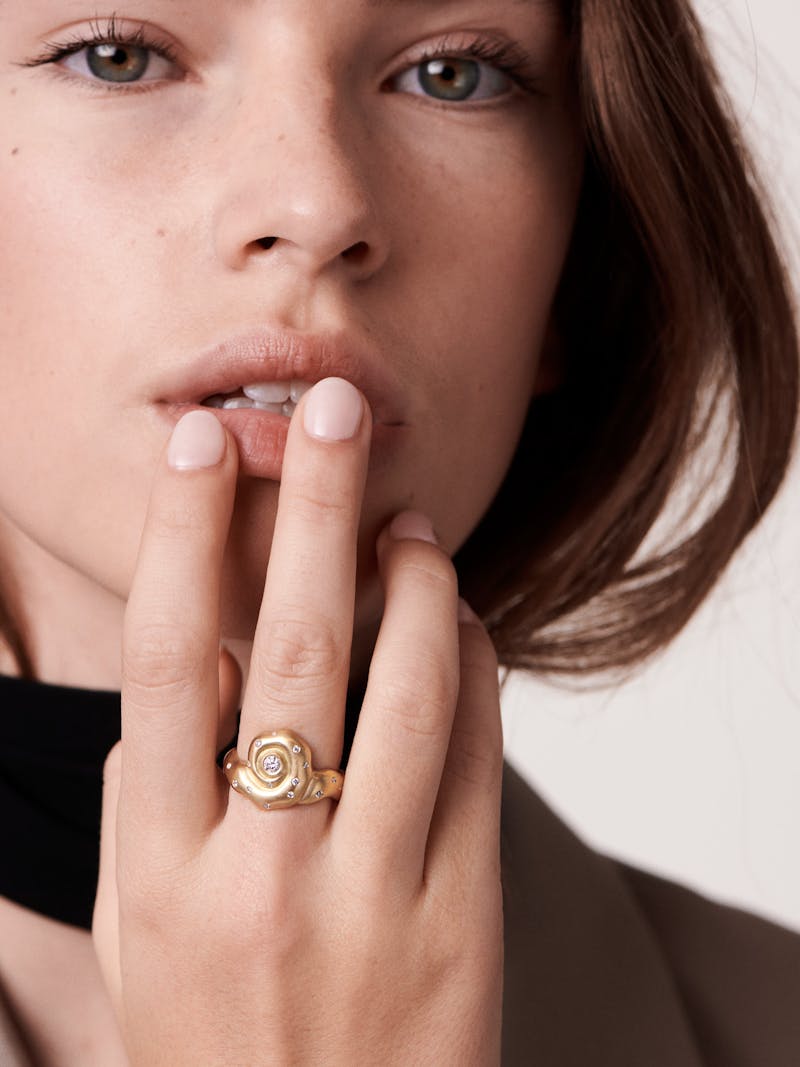
.jpg?ixlib=gatsbyFP&auto=compress%2Cformat&fit=max&w=800&h=1067)
